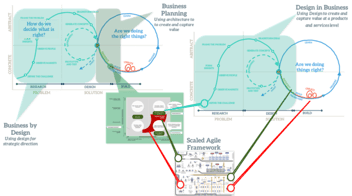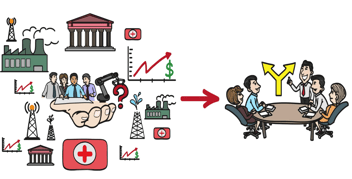I have stood in front of many senior stakeholders over the years. Some have slapped me on the back, and extended the hand of friendship. Others have sworn at me, asking me never to return. Some have invited me back year after year after year to tell them the same thing. I’ve pretty much seen most of them. Sometimes I’m asked to rock the boat, sometimes I offer this service free of charge. I freely admit that I like to rock the boat as I like being a bit of a disruptor. When I see mental models that need breaking, I can’t help myself but make an effort to break them. This recently happened at my daughter’s school camp, where the semi-Orwellian nature of the education system and some of its ridiculous rules got me into trouble a few times with the teachers. However, my group of stakeholders, my daughter and her friends, were suitably enchanted and impressed. Score one for dad.
I’d like to discuss a particular response with you in this post. It’s a feeling of being overwhelmed. My stakeholders are extremely busy people, and in an age of iPhone user experiences and simplicity, they often expect the same level of simplicity in how we deliver their outcomes and interact with them. Depending upon when we are brought into the process, this feeling of being overwhelmed will vary. I believe it is proportional to the delivery cycle. The more abstract phases of the projects like design and strategy tend to be less stressful and overwhelming. The risk is higher but there is still room to maneuver and time to change. The further you move down the cycle into business planning, architecture and delivery, the less wriggle room there is. Budgets are tighter, expectations are higher, and stress is up.
Over time we have created a plethora of tools to help us solve problems and move stuff from the strategy space to the delivery space, or from the mystery space to the algorithm space. Strategic planning, business planning, project management, architecture, agile, lean, six sigma, scrum…the list goes on. Each of these is designed to create some form of meaning for different stakeholders and reduce the complexity into bite size chunks. I often find that these disciplines are vying for territorial rights with the stakeholder and the mysterious entity called “the business”. But these disciplines suffer from the very thing they are designed to prevent – misalignment, lack of coherency and lack of cooperation. They themselves have become fiefdoms in the support function of the business and often create a strong sense of exasperation within the business community.
Design, Architecture and Agile
In this post I want to focus on three disciplines: design, architecture and agile. All three of these are needed to help develop what is being referred to as an agile organization. Agile is being used a lot in the industry, and can have varying meanings. However, when I refer to an agile organization, I am referring to one that is adaptive, and is able to learn faster and better than its competitors. A subset of an agile organization is the discipline of Agile delivery.
Each of these three disciplines has a different scope for moving organizations through the knowledge funnel, taking the unknown into the known and codifying it in processes and technology in order to exploit it. The journey through this funnel is one from exploration to exploitation, and hence requires three different mindsets and approaches.
The three disciplines can be used to help us answer some of the fundamental questions within our organization:
- How do we decide what it is right?
- Are we doing the right things?
- Are we doing things right?
In order to break these down into our disciplines I’ve positioned them onto an adapted version of the Nordstrom model.
How do we decide what is right?
This is all about changing “why you do it” and focusses on context, values and system dynamics. Its moving through the design process to come up with the answer of why we want to be doing this, and why it works. I call this the Business by Design space, it uses the discipline of design to help with strategic direction. This is where you design to move away from differentiating around products and services, and look to reboot your business model to open up new and uncontested markets and create disruption in the industry.
Business models are like yoghurt; they eventually go sour. So they need to be rebooted. Historically this occurred in line with the economic lifecycle. Your business model could last you decades. However, the world has become a smaller place, and digital has reduced the time and space between people, organizations and countries. Therefore the economic lifecycle has accelerated, and so too must our ability to create new business models.
Finding the right business model is the “holy grail” of the industry, since you need to find the right match between the create value for customer and the capture value for business. The process of finding this match is the search for the business model heuristic. Therefore this stage is focused on understanding market and customer dynamics and the associated value creation required for these, and then creating the business model to create and capture that value.
The Design discipline is used to generate insights, ideate, prototype and validate these models. It’s here that you need to facilitate strategic conversations and come up with a candidate set of business models that can be tested for desirability, viability and feasibility within the business. During this stage you will need to look at the known 55 business model patterns, and create new mixes by leveraging or rebuilding models from other industries. You are prototyping your business model at the thinking level.
What’s key about this phase is the need for a clear understanding of values and value. Since a business model creates value for customers and captures value for shareholders, a strong coherent understanding of what value is, is needed. This is the Achilles heel of strategic design since its often missing, incoherent or misunderstood. I see this time and time again, lots of strategies and goals but no value model. Incoherency at the value model level will inevitably result in the creation of a business model that will be incoherent, with all of its associated implications across the capex and opex landscape.
Are we doing the right things?
This is all about understanding and designing “what you do” and focusses on assumptions, insights and patterns. Its moving through the design process to come up with the answer of “here’s how this works”. We call this the Business planning space; it uses the discipline of business architecture to understand how it must all connect.
Within this stage you need to validate the candidate business models, and consider how you are going to generate the value you have defined. It’s pointless having nice business models if it’s going to take too long and cost too much to implement. Therefore before any strategic levers are pulled its ideal to “play out” these business models into the organization. This is not a complex exercise, but does require an insight into the current investment landscape, current pain points, risks and maturity. These are lenses that you apply to each of the candidate business models to determine viability and feasibility.
Understanding the “how” can be driven by following an experience blueprint. It’s a great way to demonstrate value to the customer but also link it to the engine of business that must produce that value. Using experience design, service design and value streams is a great recipe to create these links.
One of my favorites is “value-based-intention”. This approach looks at the final outcome that the customer is looking to achieve and designs the experiences, services, products, capabilities and resources around delivering that. An example of value based intention is “I want to move from Sydney to Melbourne and build my own house”, or “I want to retire right”. There are a host of complex touchpoints that need to be addressed to enable this.
What value we create from these touchpoints is the point of business model design. How we create that value is the focus of business planning and architecture.
One of the activities I like to do during this stage is the complexity vs value graph. (For a mored detailed video tutorial of this model watch it here)
Take your products, services or capabilities and drop them onto this graph. This is the one of the outcomes of a business planning phase. You should have an understanding of how each business model will be realized onto a graph such as this. Those items that arrive in the top right quadrant are what we call complex and high value. In most situations we don’t won’t have a clear understanding of this quadrant because whatever is in here is still taking shape. This occurs a lot in businesses that are going through some form of transformation.
An example of this was a client who wanted to add financial services to their portfolio. In other words, they wanted to become a bank. However, this business model was a whole new addition to this organization and there were many unknowns. Therefore it was too early to do architecture, agile, solution design or anything else in this quadrant until we could understand the problem space better and ideate around how we might address some of those problems.
The lever to use in this quadrant is not an IT lever. In fact it’s not even a process lever. There are still so many unknowns here that the main lever to focus on is people. Hence everything that lands up in this quadrant is ideal for the design thinking process and its human centered nature. I had a military defense client who had built the most functionally rich ERP system I had ever seen. The problem was they were building it for stuff in this quadrant. That vendor was smiling all the way to the bank, since this top right quadrant was in a state of flux, always moving, always changing, and so too are the vendor change requests and scope variations.
Items that land up in the other quadrants can now be flicked off to different disciplines. The bottom right is an improvement quadrant. Since the heuristics are understood it’s now time to codify these into processes, therefore process improvement techniques can be used here. There is also space for technology build projects here, but only those that are high value and differentiating.
The bottom left quadrant is a strong technology and automation quadrant. A lot of commercial off-the-shelf activity can occur here. Its low value and commodity technology like ERP so buy outweighs build. Top left quadrant is the outsource space. Assume you are testing a business model that moves away from product manufacturing and aims to get closet to customers. That product manufacturing capability is no longer a key differentiator, but it’s still needed and it’s still complex. Outsource this to partners and add a partner management capability. These and many types of similar conversations can now be had around this one graph.
Taking each business model and playing it out to this level as well as looking at start, stop and continue activities will allow you to determine which business model will deliver the most value in the last amount of time. This information can be used as an input back into strategic design. Applying the lean startup processes means we can now adapt our strategy based upon a robust business model exploration and validation exercise.
Are we doing things right?
The next stage is to create a means to deliver effectively against these quadrants and then learn and adapt faster.
- Top right – take these through another cycle of design. We call this “Design in Business” since you now apply design at a more granular level to focus on services, products and processes. These are referred to as third and second order problems, since they relate to interactions that are person-to-person or person-to-system. Service design occurs at this stage and traverses the entire knowledge funnel from top right to bottom left as it seeks to design more engaging services for customers.
- Bottom right – the focus lever here is processes. This does not exclude other resources but process contains the rules, policies and procedures that encode your thinking into the business to create value through repeatability. Without repeatability you can’t scale. Without understanding your processes you will struggle to create differentiation and fall into a mode of using processes already captured in off-the-shelf technology. There’s not much differentiation there as every other competitor has access to these standards.
- The only caution I provide here is to focus only on the processes that are defined in the value streams and experiences that have been created in the business planning phase. This will help you deliver the value to your customer and to your business sooner.
I would recommend that you start your agile journey by focusing the agile activities on the bottom left quadrant and begin to move these into the lower right as the next step. Agile does not operate in the top right quadrant, that’s the design space. Agile also does not function in the business model innovation and strategic design space. These are too abstract. Agile also does not do too well in the business architecture space although linkages to architecture are well documented. Therefore the architecture discipline is required to design the engine of the business and begin to create the bridge between concrete and abstract.







